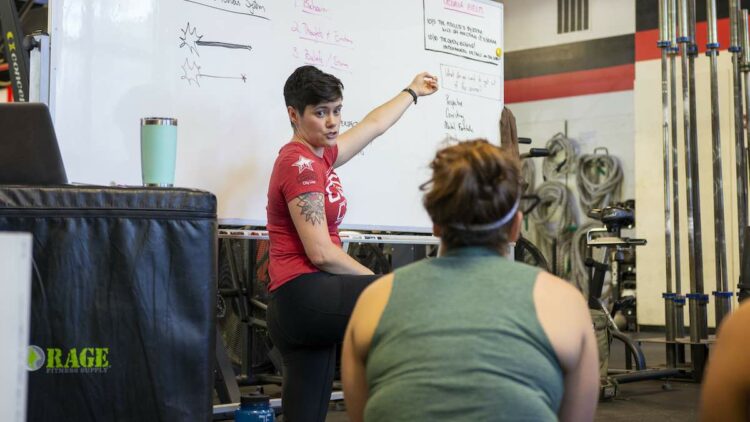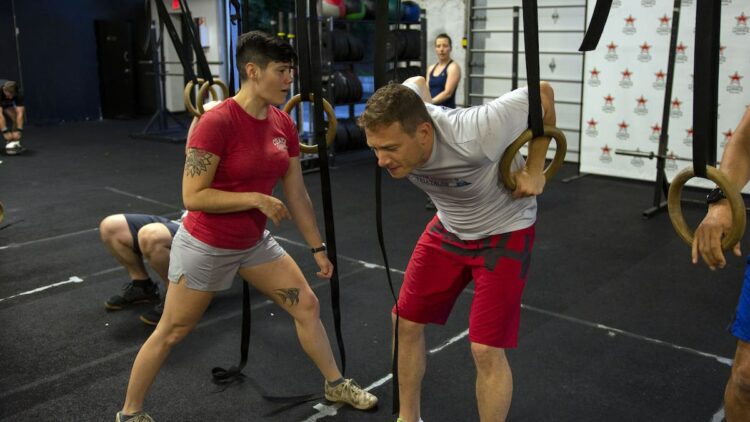How Self-Talk Can Improve (or Hurt) Training and Athletic Performance | BarBend (original) (raw)
“Grace” is one of those workouts that has historically freaked me out: 30 clean & jerks for time is a simple workout (and I love weightlifting), but like many CrossFitters, I used to find benchmark workouts more than physically challenging — they were challenging to my mindset.
I would often enter the gym in a great mood, excited to try the workout, convinced that I would PR. But by the time the workout had started, I had reverted to anxiety and fear. My thoughts would turn to “what if?”
“What if I’m worse than I was last time?”
“What if other people judge me?”
The last time I performed “Grace” was two years ago, and I was so wrapped up in my head that I stopped the workout to ask my cheering squad to go away.

Recently, I did “Grace” again, and I easily PR’d by over a minute, without the idea of a PR crossing my mind once.
What was the difference? It would be easy to say that I’m fitter, and perhaps I am, but the main difference that I felt in the workout was what was happening between my ears.
Self-talk is the inner language, imagery, and emotions we use to describe to ourselves what is happening now and what will happen in the future. Many of us know when we’re experiencing helpful, or serving, self-talk and when we’re experiencing non-serving self-talk.
Mindset Pitfalls in Training
Self-talk is a reflection of our mindset. During workouts, the ideal mindset is focused on the present. There’s very little distracting mental chatter. Most of the mind is bent on task accomplishment, positive encouragement, or technique. It’s present and focused on what’s under our control.
Unfortunately, this mental state is often clouded by doubts and fears that lead to common forms of training self-sabotage: either holding back from giving full effort or getting distracted by comparisons or other uncontrollable factors. Doubts and fears are habits of thought, and those habits lead to a pattern of negative self-talk that hinders progress over time.
[Related: How do you cope with training plateaus?]
Understanding Perceived Effort
Negative self-talk reflects our beliefs about our perceived effort. Perceived effort is a subjective measurement of how difficult something feels, versus an objective measurement of capacity. For example, back squats at 80 percent of one’s one-rep max are objective, whereas back squats that rate an 8 out of 10 in difficulty are subjective.
Subjective capacity changes day to day, depending on recovery and mindset. When we’re in a “good mood,” our output feels good. When we’re in a “bad mood,” we’ll find that the same output feels harder, more effortful.
In his book How Bad Do You Want It?, writer and coach Matt Fitzgerald explains that perceived effort has two levels: 1) how we feel and 2) how we feel about how we feel. Our beliefs influence how we interpret difficult efforts. Certain beliefs reduce perceived effort, and others increase perceived effort.
Beliefs That Increase Perceived Effort
A fixed mindset is one of the most common causes of negative self-talk. In a fixed mindset, athletes believe that talent is the most important marker for success and that there is little to gain from putting in the effort. This is demotivating and causes us to sabotage ourselves.
When effort doesn’t pay off, why would we keep trying? A results-based focus. Comparisons and using our results to measure our successes create self-consciousness, a hyper-awareness of ourselves that is at best distracting and at worst debilitating. It can cause us to freeze in a workout (like I did in “Grace”), unable to perform well because we’re focused on what’s out of our control.

Perfectionism is a pervasive and insidious belief system that leads to all-or-nothing thinking. In this belief, either a training session was amazing, or it was terrible. Either I PR’d my lift or I failed my training session. When we become self-critical and magnify the negative, we’re more likely to self-sabotage.
The big theme to these beliefs that make workouts feel more difficult is that they focus on results: it’s a performative, appearance-based mindset, intent on external values of success, like hitting PRs. A large part of the reason this increases perceived effort is because we’re focused on what we don’t have control over.
Beliefs That Reduce Perceived Effort
A growth mindset is a belief that the value of what we do comes from our effort, not the results of our effort. A growth mindset recognizes that character is built through struggle and adversity, and therefore, the results matter less than the act of striving.
A process-based focus is a paradox of holding a long term and a short term perspective at the same time. In the long term, an individual workout when stacked against every other workout we’ll do in our lives doesn’t matter. In the short term, the habits of effort, focus, and preparation we put into each individual workout is what leads to success.
Progress over perfection is a state of mind that accepts that 1) perfection is impossible, and 2) it’s not desirable. A “perfect” training session teaches us nothing. Believing in progress over perfection gives us the tools to see mistakes as growth opportunities, a new challenge to rise to.
When it comes to beliefs that reduce perceived effort, that make training and competing feel easier, we can see they share a certain quality: habits of thought.
Habits are within our control; they can be built or broken. Growth mindset individuals make a habit of valuing challenge, of treating difficult situations as opportunities. A process-based focus builds habits (including self-talk) that lead to success, and progress over perfection is a habit of thought that maintains positivity and an honest awareness of where we’re at.
[Related: How to use CrossFit Open results to improve your training.]
How Do We Change Beliefs?
We change fixed mindset, perfectionism, and focusing on results by first building a deep level of awareness of how these beliefs are impacting us. What kinds of thoughts and emotions arise during training and competing? What behaviors follow? What beliefs about our worth or value do these point to?
Once we have this knowledge, we can consciously rewrite our beliefs. Rewriting beliefs requires action–it’s not a mental exercise. We cannot lie to ourselves about what we believe, we need to build proof to ourselves.
For example, in the case of my “Grace” experiences, a fear of failure (a hallmark of a fixed mindset) caused 30 clean and jerks to feel like an insurmountable task. My success was defined too narrowly and outside of my control: by impressing others with my performance. This made the workout feel harder.
What I’ve learned over the last two years is to define success based on being present. During my latest “Grace,” when I found myself noticing others’ performance, I simply redirected my thoughts to my plan and how I wanted to execute my lifts.
While I finished with a PR, I found myself more proud of having been present and relaxed than finishing a minute faster than my previous time. In acknowledging the effort I had to put in over the last two years to achieve that state of mind, I’ve maintained a focus on process and rewritten the belief that I have to impress others with my physical performances.
I’m only beholden to myself, just as your training and competing are only for you. Giving our best effort, committing to learning from our setbacks versus wallowing in them, and focusing on what’s under our control are all mental habits that lead to better self-talk.
Images courtesy TJ Danenza